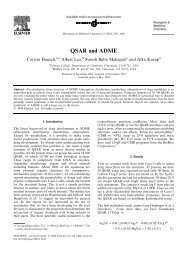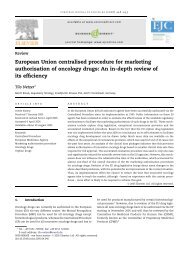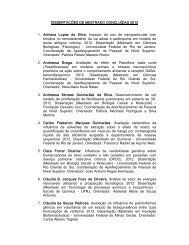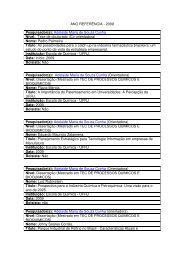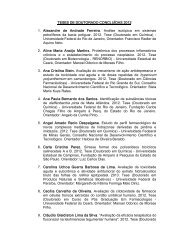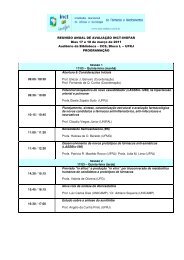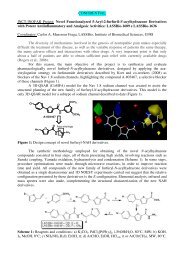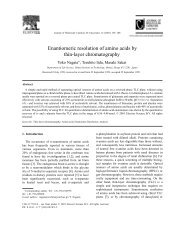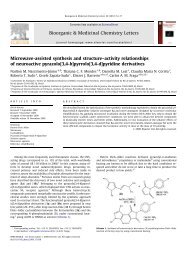View - ResearchGate
View - ResearchGate
View - ResearchGate
- No tags were found...
You also want an ePaper? Increase the reach of your titles
YUMPU automatically turns print PDFs into web optimized ePapers that Google loves.
Perspective Journal of Medicinal Chemistry, 2004, Vol. 47, No. 18 4341Advantages of Tracking BiologicalTransformation during the Drug DesignProcessThere are a number of advantages for screening drugcandidates for active metabolites during drug discovery.The primary reason is that the process may lead to thediscovery of a drug candidate with superior drug developabilityattributes such as (1) improved pharmacodynamics,(2) improved pharmacokinetics, (3) lower probabilityfor drug-drug interactions, (4) less variablepharmacokinetics and/or pharmacodynamics, (5) improvedoverall safety profile, and (6) improved physicochemicalproperties (e.g., solubility).Other advantages of early screening for active metabolitesinclude the potential for modifications of theentire chemical class (chemotype) to improve overallcharacteristics. 1,18 Further, early discovery of activemetabolites provides a more complete patent protectionof the parent molecule. Additionally, tracking activemetabolites at the drug discovery stage will allow forthe correct interpretation of the pharmacological effectobserved in preclinical species in relation to a predictedeffect in humans. In other words, if an active metaboliteis responsible for significant activity in a species usedfor preclinical efficacy determination, there is a significantrisk that the effect will be dramatically differentin humans unless similar levels of metabolite areachieved in humans.Active metabolites possessing one or more of theabove attributes have been found for a number ofmarketed drugs and have led to the introduction of themetabolites as commercial products. Several examplesof active metabolites that have become marketed drugsare discussed below.Desloratadine (Clarinex) now marketed as a secondgenerationantihistamine agent is an active metaboliteof loratadine (Claritin) (Figure 2). It is approximately10-fold more potent in vivo in human than the parentdrug. 19,20 Desloratidine has lower oral clearance withgreater systemic concentrations at equivalent oral dosesand has a longer plasma elimination half-life comparedto the parent compound in human. As a result of itssuperior pharmacokinetics and pharmacodynamic profiles,the standard human dose is half as much as thatof loratadine. It also shows less pharmacokinetic variabilityin comparison to the parent drug. 21,22Morphine-6-O-glucuronide, a widely used analgesic,is an active metabolite of morphine possessing pharmacologicalactivity greater than that of the parentcompound (Figure 1). 23,24 Upon chronic treatment, thepharmacokinetic profile of morphine-6-O-glucuronideled to higher plasma concentrations than morphine,contributing to its better clinical effect. 25 Morphine-6-O-glucuronide also showed an improved side effectprofile, with a lower incidence of nausea and vomitingcommonly observed with the parent drug. 23Cetirizine (Zyrtec), a second-generation antihistamine,is an active metabolite of hydroxyzine (Atarax)(Figure 2). Cetirizine has greater affinity for the H 1receptor and, in contrast to hydroxyzine, is a nonsedatingagent at least partially because of its lack ofdistribution to brain tissue. 7,26Fexofenadine (Allegra), another antihistamine agent,is an active metabolite of terfenadine (Figure 2). 8,27Figure 2. Examples of biotransformation reactions that ledto active metabolites that have been developed and marketedas drugs.Terfenadine undergoes extensive first-pass metabolismthat is predominantly mediated by CYP3A4 and formsfexofenadine as the major circulating metabolite. Terfenadinewas shown to promote the inhibition of cardiacion channels (potassium ion currents) leading to prolongationof the QT c interval and ventricular arrhythmia.28,29 Coadministration of terfenadine with CYP3A4inhibitors such as ketoconazole significantly altered itspharmacokinetic profile, resulting in an increase inplasma concentration potentially leading to fatal cardiacarrhythmia. 30 In contrast, no change in the QT c intervalwas observed with fexofenadine when administeredalone or in combination with ketoconazole. As a result,terfenadine was withdrawn from the market and wasreplaced with fexofenadine.In most cases, further metabolism of active metabolitesleads to the formation of fewer total metabolitescompared to the parent compound. As a result, the useof an active metabolite as drug may lessen the chancefor off-target toxicity that may be caused by one or moreextra metabolites formed from the parent compound,even when the parent compound itself has no intrinsictoxicity. Moreover, most active metabolites are productsof phase I functionalization reactions and as such aremore susceptible to phase II conjugation reactions.Phase II conjugation reactions result in the formationof secondary metabolites that, in general, are safelycleared from the body. For example phenacetin, whichis no longer in use in humans, is metabolized to anumber of metabolites. Of the many phenacetin metabolicpathways, the O-deethylation pathway leads to theformation of acetaminophen (Figure 2) (a more analgesicagent than phenacetin), whereas N-hydroxylation ofphenacetin leads to the formation of a toxic metabolitethat induces methemoglobinemia and hemolytic ane-



